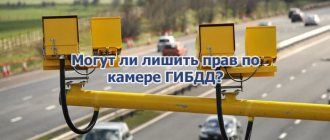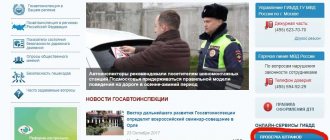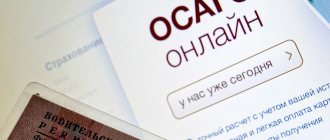According to Art. 3.8. The Code of Administrative Offenses, the current administrative legislation provides for such a measure of punishment for violators of traffic rules as the revocation of a special right. A driver’s license can be deprived only for serious or systematic violations of traffic rules and only in cases where the corresponding sanction is provided for by one of the articles of the Special Part of the Code of Administrative Offenses of the Russian Federation (that is, one of the articles of Chapters 5 - 21 of the Code of Administrative Offenses of the Russian Federation, for more details, see the picture). For example, for driving while intoxicated (Part 1, Article 12.8.), for leaving a railway crossing with a closed barrier (Part 1, Article 12.10.), for overtaking through continuous markings (Part 4, Article 12.15. ).
What is a petition for non-revocation of a driver's license?
A petition (hereinafter also referred to as a petition) for the non-application of such a sanction as deprivation of a driver’s license is understood as a written document submitted to the court by a citizen held accountable, containing a request to impose another punishment, regulated by the relevant article of the Special Part of the Code of Administrative Offences, indicating specific reasons and the circumstances supporting this request.
Attention! If you have any questions, you can chat for free with a lawyer at the bottom of the screen or call Moscow; Saint Petersburg; Free call for all of Russia.
Filing a petition for non-deprivation of a driver's license makes sense only if the case of an administrative violation is considered by the court. This is possible in two cases:
- if only the court has the authority to impose punishment for the relevant violation;
- or if the traffic police inspector has transferred the case materials for consideration to a judicial authority (below is a list of violations for which the inspector himself chooses - either to impose a punishment “on the spot”, or to transfer the case materials for consideration to the court).
In other cases, filing a petition for non-deprivation of a driver’s license does not make sense. Justification – in accordance with Art. 3.8. Code of Administrative Offenses, only a court can deprive rights. Therefore, if the justice body cannot consider a case of violation at all (see below for a list of such offenses), then under no circumstances can they confiscate the driving license.
That is, for such violations, as a rule, punishment is established either in the form of a warning or in the form of a fine and, on the basis of stat. 28.6. Code of Administrative Offences, the inspector in these cases simply draws up a resolution (without a protocol), hands over a copy with payment details and releases the driver.
Let's sum it up
- The petition is submitted if you admit your guilt and agree with the classification of the violation by the traffic police officer.
- The document should be submitted if the article contains an alternative measure of liability in the form of a fine.
- A petition can be submitted at all stages of the procedure for deprivation of a driver's license.
- The sooner the document is submitted, the greater the chances of its satisfaction.
- Be sure to include all required information in your application and clearly formulate your request.
- Prepare documentation that will support your grounds for mitigation of liability.
Normative base
The regulatory framework for filing a petition for non-deprivation of a driver’s license consists of the following articles of the Administrative Code:
| Link to article, part, paragraph of the Code of Administrative Offenses | A comment |
| Part 1 stat. 24.4., as well as part 1 stat. 25.1. | It says that the violator can file petitions, and they must be considered by the court. |
| Part 2 stat. 24.4. | It is indicated that petitions must be made in writing. The court will consider them immediately upon receipt. |
| Clause 6 stat. 29.1. | It is said that the judge, when preparing to consider the case, must check whether there are any submitted petitions and challenges. |
| Part 2 stat. 29.6. | It is said that the judge may extend the established two-month period for consideration of the case if any petitions are received from the participants in the process for non-deprivation of a driver’s license. |
Who makes the decision
The decision can be made by different authorities, depending on where and to whom the petition was sent. If the petition was addressed to the traffic police, then the decision, either positive or negative, is made by the head of the traffic police department or the traffic police commission. If a document is submitted to the court in the name of a judge, the decision is made only by the court. If a petition is rejected, the authority that issued the verdict must provide arguments and reasons for the refusal in writing.
Important! If you do not have enough evidence of innocence, then you should not file a petition only with a request not to deprive of your rights; from practice it follows that the court is more irritated by this kind of petition. The result in such cases will be the strictest.
When filing a petition directly during a court hearing, it is also not advisable, because the court is obliged to consider in detail all the evidence presented in the petition. There is no time left for this during the process and such a document is more likely to be rejected.
Lawyers often advise submitting during a hearing not a petition, but an explanatory note; this is a kind of trick, since the circumstances set out in it, essentially evidence, cannot be rejected. This means they will be involved in the case. This note sets out the reasons for violating the rules, may include documents mitigating the guilt, and a request to replace the punishment with a fine. In terms of content, such a note is the same as a petition, but cannot be rejected.
If the traffic police rejected the petition, the court will most likely side with the traffic police. And you need to submit an even more complete petition to the court, with other compelling documents indicating that the driver needs a license, and the traffic violation occurred for reasons beyond his control.
How to pay the state fee for a driver’s license through the State Services portal
Reasons for the need to submit a petition for non-deprivation of a driver’s license
A petition for non-revocation of a driver's license must be submitted only if the following are not disputed:
- the very fact of committing an administrative offense;
- actions of traffic police officials when recording a violation and drawing up a protocol;
- the presence of guilt of the citizen held accountable.
In other words, this petition is submitted if the driver agrees that he actually violated the traffic rules, but for one reason or another does not want to be punished in the form of revocation of the driving license.
For example, if activities related to driving a car are the main and only source of income, then deprivation of a driver’s license will put the driver in a difficult financial situation.
There may be other reasons for filing a petition, which are indicated in Part 2 of Art. 4.1. Code of Administrative Offenses, for example:
- property status of the perpetrator;
- the nature of the offense committed;
- the identity of the offender;
- the presence of circumstances mitigating liability.
Extenuating circumstances
The law also provides for mitigating circumstances that can save the driver from being deprived of his right to drive a car.
Typically, mitigating circumstances that are considered are:
- Minors, disabled people who are dependent on the offender.
- Driving is the only source of income.
- No overdue fines or other penalties.
- Photo, video evidence indicating the driver’s complete or partial innocence.
If you have violated traffic rules due to poor health or other reasons. Never shy away from the opportunity to be tested for alcohol. If you refused, you automatically admitted that you were drunk. In this case, no mitigating circumstances will help and the penalty will be to the fullest extent in the form of a fine of up to 30,000 rubles and deprivation of rights for up to 3 years.
At what stage is a petition for non-deprivation of a driver's license submitted?
In Art. 24.4. The Code of Administrative Offenses does not say at what stage petitions should be submitted.
Judging from the meaning of the totality of regulatory provisions of the Code of Administrative Offenses, filing a petition for non-deprivation of a driver’s license can be done:
- starting from the moment the traffic police inspector fulfilled the obligation provided for in Part 1 of Art. 28.8. Code of Administrative Offenses - that is, transferred the case materials to the judge for consideration;
- and ending with the moment when the judge announces the decision on the case (Part 1 of Article 29.11.).
It is recommended not to delay and to submit an application for non-deprivation of a driver’s license while preparing for the consideration (clause 6 of Article 29.1.).
Package of necessary documents
The petition must be accompanied by strong documented reasons that the driver deserves leniency. It can be:
- photo and video materials;
- DVR data;
- copy of the protocol;
- certificate and characteristics from the place of study;
- characteristics from the place of work;
- certificate of disability (if there are relatives with disabilities in their care);
- a certificate from the registry office about family composition, documents for children (if any);
- witness statements.
Rules for filling out an application for non-deprivation of a driver's license
The current administrative regulations do not regulate exactly how applications should be filled out. It only says that requests must be made in writing.
This means that there is no unified form. Therefore, it is recommended that a traffic violator draw up a petition for non-deprivation of a driver’s license on the basis of the rules that have developed and are applied in business practice when filing such applications.
The portal’s specialists have developed step-by-step instructions for filling out an application for non-deprivation of a driver’s license based on business rules:
- take a standard A4 sheet;
- we decide how exactly we will fill it out - by hand or using typewritten (computer) technology;
- we draw up a “header” in which we indicate the name of the court where the document is being submitted, the full name of the person held accountable, and the number of the administrative case pending in this court;
- in the center we write the name of the document - that is, “Application for non-deprivation of a driver’s license”;
- further we describe the situation in detail - the date, time of the violation, its essence, link to the paragraph, part, article of the Code of Administrative Offenses, full name of the traffic police inspector who recorded the offense, details of the state registration plate, details of the drawn up protocol, make and model of the car and other data;
- then we write a clear agreement with the charges brought, that is, there is no need to dispute the very fact of the violation, the actions of the traffic police officers, etc.;
- We indicate a list of reasons due to which the driver should not be deprived of his license (for example, the presence of several young children, a difficult financial situation, an indication that the car is the main source of income, etc.);
- then in the center we put the word “I ask” and write a request to the court not to deprive the driver of the right to license, but to impose such and such a punishment (for example, administrative arrest);
- Finally, we enter the date of the application, signature and transcript.
You can ask for such and such a punishment if it is provided for in the relevant article. For example, for leaving the scene of an accident in accordance with Part 2 of Art. 12.27. provided:
- or deprivation of rights from 1 to 1.5 years;
- or administrative arrest for up to 15 days.
Accordingly, in this case it is necessary to apply for an arrest.
Or, for example, you can apply to replace the deprivation with an administrative fine (see, for example, Part 1 and Part 2 of Article 12.24 of the Administrative Code).
How to write a petition for an employee (from the place of work)? Sample
A petition from the workplace is a fairly common way to influence the opinions and decisions of officials of various organizations, be it the head of a kindergarten or a federal judge. In the first case, the petition can help to obtain a place in a preschool institution for the employee’s child, in the second, it can play an important role in determining the amount of the punishment.
Despite the fact that the law practically does not regulate the procedure for drawing up and submitting a petition from the place of work, it is not difficult to find a sample; just ask the corresponding request in Internet search engines. However, ready-made templates are not always able to fully reflect the essence of the current situation, so it is worth following a number of recommendations:
Sample of filling out an application for non-deprivation of a driver's license
The portal's lawyers have developed a sample application form for non-deprivation of a driver's license in WORD format. All you need to do is enter the required data in the appropriate fields (an explanation of what exactly needs to be written is indicated below these fields), and then print.
Institutions for filing a petition for non-deprivation of a driver's license
In accordance with the last paragraph of Part 3 of Art. 23.1. Administrative Code, most cases related to traffic violations are considered by magistrates. Only in certain cases can a case be referred for consideration:
- district court (for example, if an employee of the Investigative Committee violated traffic rules - paragraph 2, part 3, article 23.1 of the Administrative Code);
- arbitration court (see paragraph 4 and paragraph 5 of part 3 of article 23.1 of the Administrative Code).
As for geographical and territorial jurisdiction, the case is considered (in general) at the place where the offense was committed (Part 1 of Article 29.5 of the Administrative Code). But if the violator submits a corresponding petition, they may also consider the driver at the place of residence.
Submitting an application from an employer to the Federal Migration Service in 2019: sample format
An application from the place of work submitted to the FMS employees is one of the main conditions for obtaining the right for a foreigner to continue working in the territory of the Russian Federation. The maximum period for which a patent is issued is 12 months, and it can be taken out in stages. However, to renew it, you must provide some documents to the local Federal Migration Service. It is this department that considers the possibility of a person who is not a resident of the country to stay in Russia and work legally.
- admission to higher education institutions and various services or benefits associated with this, for example, the provision of a hostel or a certain schedule of study or examinations;
- encouraging an employee, presenting him for a certificate or bonus at a higher level;
Required documents for filing an application
The application for non-deprivation of a driver's license must be accompanied by documents that confirm the circumstances listed by the violator in the text of the document, according to which it is better to replace the deprivation with another type of administrative punishment.
Of course, a unified package of documents has not been approved, since it will vary depending on the specific case and circumstances. Here is an approximate list of necessary documents for filing a petition for non-deprivation of a driver’s license:
- a copy of the offender’s passport;
- a copy of the violation protocol drawn up in accordance with Art. 28.2.Administrative Code;
- characteristics from the place of work, study, residence, signed, respectively, by the head of the production, educational organization or housemates;
- certificates from medical organizations confirming the presence of relatives with serious illnesses and requiring constant care;
- documents confirming the presence of mitigating circumstances (for example, a certificate of pregnancy or a woman has a young child - clause 10, part 1, article 4.2 of the Administrative Code);
- papers certifying the compensation for damage caused by an offense (for example, about voluntary payment of moral damages in favor of a hit pedestrian - stat. 12.24. Code of Administrative Offences);
- other documents that, in the opinion of the offender, may prompt the court to make a decision not to impose deprivation of rights, but another punishment provided for in the relevant article.
What documents are required
Standard list of documents:
- characteristics from the place of work to the court about non-deprivation of rights. If you contact the traffic police, you should submit a reference to the traffic police about not depriving your rights, a sample of which can be found on specialized websites;
- a certificate from a drug dispensary confirming the fact that the applicant is not registered in this institution;
- birth certificates of children and other persons dependent on the applicant, if deprivation of rights prevents the latter from performing official duties and, accordingly, earning money;
- if the car was the only means of transportation for a disabled person, it is necessary to provide a disability certificate;
- a certificate confirming the absence of similar violations in the past;
- evidence indicating the presence of circumstances mitigating the applicant’s guilt.
Note! Not only the offender, but also other interested parties have the right to submit an application. Thus, the applicant may be the employer of the offender, who, as a result of the imposition of this type of punishment, lost an employee.
As practice shows, in most cases the courts do not grant requests for non-deprivation of rights, but this does not deprive the applicant of the opportunity to appeal the decision through an appeal. An appeal requires a more professional approach, so it is better to seek help from an experienced motor vehicle lawyer. The law provides a period during which the applicant can file an appeal against the decision of the magistrate; it is 10 days.
Documents must be submitted in both originals and copies.
Any documents that can confirm the need to mitigate guilt are attached, such as:
- Certificate of accident-free driving from the traffic police.
- Birth certificates, proof of disability of dependents.
- A document proving that the offender is the only breadwinner in the family.
- A certificate from a narcologist stating that he is not registered.
- Statements from witnesses to the incident, if they mitigate guilt.
- A petition for commutation of punishment, in fact, a petition itself.
The standard form for such a petition is not approved by law; the document is drawn up in free form according to the general rules for drawing up statements of claim. Paragraph 2 of Article 24.4 of the Code of Administrative Offenses of the Russian Federation stipulates that petitions must be submitted in writing. And although the document is drawn up arbitrarily, it must clearly display all the information on the case under consideration and the corresponding request. A special feature of filing an application for non-deprivation of a driver’s license is the inclusion in its text of the following information:
- Description of the main circumstances of the offense in question (time, place, participants, consequences of the offense, etc.).
- An indication of the reasons why the court should decide not to deprive the person’s driver’s license.
- A formulated request to the court (i.e. “I ask you not to deprive your driver’s license and limit yourself to punishment in the form of ...”).
- Applications. The petition should be accompanied by documentation that could confirm the reasons indicated by the respondent: birth certificates of children, certificates from a medical institution about the health status of any of the family members (if there are dependents), references from the place of work, photo and video materials from the scene of the accident etc.
Depending on the specifics of a particular case, in a petition (as well as in a complaint after a court decision), an interested person may refer to circumstances such as the expiration of the statute of limitations, violation of medical examination regulations, unreasonable refusal to accept testimony of witnesses, and others.
Article 26.11 of the Code of Administrative Offenses states that, along with the petition, the judge must consider all the evidence that is attached to it. However, there is no legally established list of papers that must be sent along with the application. Their composition will depend on the nature of the case under consideration. In the case of a request for non-deprivation of rights, this is usually:
- a description compiled and written at the place of work or study of the accused;
- a certificate issued by a medical institution stating that the accused is not undergoing treatment at a narcologist’s office;
- materials, photographs and video footage that prove the innocence of the accused;
- if the driver has minor children for whom he is responsible, then he must attach a birth certificate;
- certificates from medical institutions, which confirms the fact that the accused has seriously ill relatives who require constant care. In this case, having a driver's license may become critical if their health condition worsens;
- certificates that serve as confirmation of the status of the sole breadwinner;
- if such a violation was committed by the accused for the first time and there were no serious consequences after it, then a certificate of the full period of driving without accidents can be attached. It can be obtained from the traffic police department;
Any other documents that can confirm the fact that after deprivation of rights a person’s condition, material and physical, will sharply deteriorate.
Step-by-step instructions for filing a petition
The entire procedure from stopping the car by a traffic police inspector, recording the offense and until the final decision is made is as follows:
- initiation of a case (Article 28.1 of the Administrative Code);
- drawing up a protocol by the traffic police official who recorded the offense (Article 28.2.) (this is done immediately after the violation is detected - Part 1 of Article 28.5.);
- handing over a copy of the protocol to the violator;
- sending the protocol for consideration to a judge within 3 days (Part 1 of Article 28.8.);
- submission by the violator of a written petition for non-deprivation of a driver’s license (for how to draw up samples, see above in the article) to the magistrate’s court located at the place where the violation was committed (or at the driver’s place of residence, if a corresponding petition was submitted);
- if the petition is rejected, a ruling is issued; if it is not rejected, then the ruling is not issued (Part 2 of Article 24.4.).
Regardless of whether the application for non-deprivation of a driver’s license is rejected or not rejected, the consideration of the case will be carried out in the general manner and within the time limits specified in Chapter 29 of the Code of Administrative Offenses, that is:
- preparation for consideration is being carried out (stat. 29.1.);
- the circumstances preventing the consideration of the case by the appointed judge are checked (Article 29.2.);
- a date and time are set for the meeting;
- Testimony of the offender, witnesses, and other persons participating in the process is heard (Part 2 of Article 29.7.);
- a date and time are set for the announcement of the decision on the case (the decision can be in one of two types - either on the imposition of punishment or on release from liability - Part 1 of Article 29.9.).
At what stage and where to apply?
You can submit a petition at any stage of consideration of a case regarding an administrative offense:
- At the time of the preliminary investigation . The request is submitted to the head of the traffic police department, who decides whether to transfer the case to a judge. Before this, the head of the State Traffic Inspectorate or a special commission will consider whether it is possible to replace the deprivation of rights with a more lenient punishment.
- At the stage of transferring the case to court . After a preliminary investigation, the traffic police transfers the case to the magistrate's court. If the case is already being considered by the court, the petition is filed in the name of the judge. The request may be granted before the date of the trial is determined or at the time of the court decision.
- During the trial . You can also submit an application at this stage. The judge determines whether to attach this document or not. If the court refuses or returns the petition to the applicant, then this must be motivated. If the petition was accepted, but the judge’s decision does not satisfy the defendant, you need to file an appeal (we wrote about when a complaint against a magistrate’s decision to deprive a driver’s license is appropriate here, and from this article you will learn about how the court hearing takes place and how you need to behave).
The petition is submitted not only in writing, but also orally. However, the second option is less effective. A written request is submitted in person or sent by registered mail with mandatory notification of its receipt. The response time to the violator's request is usually one day. The petition itself can be considered at any stage of the process, including at the time of the final verdict by the highest authorities. But filing such a petition does not relieve the offender from responsibility for the crime and may be completely rejected by the court or investigative body.
Taking into account the different stages of consideration of the case, the document can be submitted:
- To the traffic police department.
- To the magistrate's court, which will make a judgment on the case.
If the judgment has already been rendered, then the petition has already been filed by the high court. To do this you need:
- Write an application for review of the court decision by higher authorities.
- Wait for the document to be accepted and find out the details of the judge who will hold the additional hearing.
Decision-making
After the expiration of the established two-month period (Part 1.1. Stat. 29.6. Code of Administrative Offenses), the court makes a decision (except for cases where the period was extended in accordance with Part 2 of Stat. 29.6.).
If the court decided to impose a punishment (that is, the guilt of the offender was established), then the decision will indicate a reasoned decision in the case (clause 6, part 1, article 29.10.).
The traffic violator will learn that the request not to revoke his driver’s license was granted only when the final verdict is announced. Of course, the court will also indicate in its ruling what it was specifically guided by when deciding to deprive of rights or impose another punishment.
Note that the court makes a decision in accordance with the general rules for imposing sanctions specified in Art. 4.1. Code of Administrative Offences. That is, the petition of the violator is not the only circumstance that entails the possibility of imposing one or another sanction. This petition may not be filed, but the court will rule on non-deprivation. The opposite is also true - the petition was granted, but the court did not take it into account and nevertheless ordered the revocation of the license (for example, if the arguments stated by the violator are insignificant or are not supported by relevant evidence).
How to write to apply to the magistrates' court?
The legislation does not establish clear requirements for the execution of an application, so the document is drawn up based on specific circumstances. But there are general recommendations for drawing up a written petition. They were developed by the Department of Legal Protection. In accordance with these recommendations, the document should consist of:
- introductory part (data of the plaintiff, defendant and court);
- presentation of details of the case that require explanation or evidence;
- the essence and presentation of the request to the judge;
- list of documents that are attached to the application.
The number of copies of originals and copies of such a document must be the same as the number of participants in the trial.
- In order for the document to be considered by the court, the name of the court or the name of the specific judge to whom the petition is submitted must be indicated.
- It is necessary to indicate the grounds on which the application is submitted (for example, the work of a driver is the only opportunity to earn money and provide for the family of A.I. Petrov).
- The main nuances concerning the consideration of the case (where, when and under what circumstances the offense was committed; the article under which the offender is held accountable; other significant facts).
- Next, you need to clearly formulate your request to the judge (for example, “I ask you not to deprive A.I. Petrov of his driver’s license”).
- Indicate the list of documents attached to the application (it may differ depending on the specific situation).
- Date of preparation and signature of the person submitting the petition (if the document is submitted from the violator’s place of work or study, then the signature is affixed by the director of the enterprise or the dean of the university).
- If necessary, a company seal.
Do not forget that an appeal is only possible within ten days.
ATTENTION! For each refusal of the court to grant a petition, a reasoned ruling must be required. Many such determinations subsequently lead to the reversal of the court decision.
All information presented in the document should be stated clearly and clearly. There is no need to describe the opinions of others or your own reasoning. Only documents that are correctly compiled will be considered.
It is better to submit a petition submitted from your place of work on company letterhead to increase the significance of the application. The applicant has no right to indicate personal assumptions, much less make recommendations to the court.
So, it’s done and the case has been transferred to the magistrate, which means the prospect of taking away the driver’s license has become more real than ever. There is no single established form for such an appeal, but a petition to the court not to deprive a driver’s license in any case must contain:
- date and place of compilation;
- full name of the judicial authority;
- passport details of the person involved;
- when the offense occurred, the main circumstances;
- under what article are they going to deprive of rights;
- a request for non-deprivation of rights and replacement of punishment with another;
- signatures, seal.
If the employer submits the paper, then a letterhead with the organization’s logo is best suited for this; this gives the document greater credibility.
Nuances
When filing a petition for non-deprivation of a driver’s license, the driver should take into account some nuances:
- if the relevant article of the Code of Administrative Offenses provides for unalternative deprivation of rights (for example, when overtaking repeatedly through a continuous line - Part 5 of Article 12.15.), then it makes no sense to submit a request for non-deprivation - it is the very fact of the violation that should be challenged, that is, to prove innocence;
- in the cases specified in Part 2 of Art. 23.1., the inspector himself decides whether to transfer the case to court or impose a fine on the spot - accordingly, a kind of “petition” that he does not transfer the case materials to the court should be submitted to the inspector (in other words, ask him to impose a fine);
- sending the case to court in accordance with Art. 28.8. does not mean that the justice authority will impose deprivation of driving license (for example, an article of the Code of Administrative Offenses provides for either a fine or deprivation of a driver’s license, but the inspector decides not to impose a fine, but to send the case to court, this does not mean that the court will now specifically impose deprivation - quite possibly a fine);
- if the petition for non-deprivation did not help, and the driver’s driving license was nevertheless revoked, all is not lost - the court’s decision can be appealed in the standard manner provided for by Chapter 30 of the Code of Administrative Offences.
How to file a petition in court
Once the decision to apply is made, a document should be prepared containing the following information:
- name of the organization to which the application is being submitted;
- date and time of document preparation;
- destination;
- briefly the most important circumstances of the case;
- the reason why the sentence should be commuted;
- please do not deprive your driver's license and limit yourself to a fine;
- signature.
You can apply not only at any stage of the consideration of the case, but also after the court verdict. In the latter case, you need to file an appeal as soon as possible, to which it is appropriate to attach a reference from your place of work or study.
An appeal can be filed within 10 days from the date of the court’s decision.
Moreover, the petition can be submitted by both the citizen deprived of his rights and his immediate management, representatives of the educational institution, as well as family members of the violator.
But it is better to contact a lawyer specializing in automobile law. Yes, it is much more expensive, but the chance of a successful outcome for the driver also increases: it is better to spend time and money finding a competent car lawyer than to not sit in the driver’s seat of a vehicle for several months (maybe years).
The form of a petition to the court for non-deprivation of a driver’s license (sample) can be found in the public domain.
Requests may be made both orally and in writing. In the latter, it is preferable: law enforcement officers are less likely to pay attention to oral statements.
Despite the fact that there is no single sample application, the document must contain the following data:
- Date and place of document preparation.
- The name of the organization to which the application is being submitted.
- Violator's passport information.
- Date of offense.
- Circumstances of the offense.
- An article under which a citizen is deprived of his rights.
- Please do not deprive your driver's license and replace the punishment.
- Signature (if available, stamp).
If, for example, an employer applies instead of a citizen, then it is better to draw up the document on corporate letterhead.
The following can be attached to the application:
- DVR information or photos (documented);
- copy of the protocol;
- characteristics from the place of study/work;
- document confirming disability (if available);
- document confirming family composition;
- witness statements (documented);
- a certificate from a drug dispensary confirming that the driver whose license they want to deprive is not registered with this institution;
- a document that confirms that in the past the driver has not committed an offense for which they now want to deprive him of his license.
It is important to always remember that a petition is not a guarantee of the return of rights. This is just an attempt to turn things in your favor, which will not necessarily be successful. Even if signed by an influential person, it remains a private request.
What remains unchanged is the violation of traffic rules and the punishment provided for this violation by the law of the Russian Federation.
The latter is much preferable, especially if the document is written on behalf of the employer or a representative of the university dean's office. Therefore, it is worth considering an approximate sample of a petition to the traffic police for non-deprivation of rights.
When filling out a petition for non-deprivation of a driver’s license from the place of work (sample), there is no point in considering the standard “cap”.
In the middle of the sheet after the “header” you need to write the word “Petition”
First, you can indicate who (the applicant), when and under what circumstances (on the way to work or study) was stopped by a traffic police officer. Next, you need to note what charge was brought against him and, if necessary, describe the results of the examination. Then you can acquit the accused, referring to his positive qualities that he showed at work or during school time.
Next point: describe as convincingly as possible that without a driver’s license a citizen will not be able to perform his duties (deliver products, communicate with clients, get to his place of study, for example). It must be indicated that this will entail serious problems for the business (loss of profit) or the organization of the educational process (he will not be able to teach classes if the accused holds a teaching position, or provide on time the necessary material required to complete the program if he is a student).
It is advisable to prove that deprivation of a citizen’s driver’s license can seriously affect the well-being of the family.
The petition should be completed by mentioning that preventive training was conducted with the driver, designed to prevent such incidents in the future.
Position, signature.
The petition - no matter from whom: the driver, family members or employer - must contain a request in a form like “I ask you not to deprive your driver’s license and replace the punishment with...”











